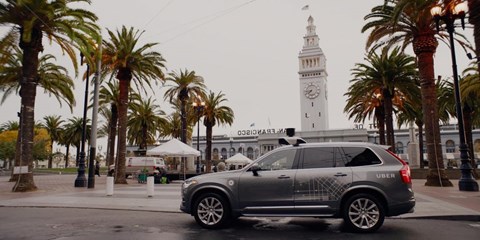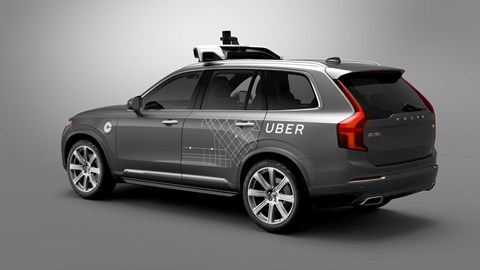► Autonomous Uber driver ‘watching TV’
► Latest in the driverless car crash saga
► Autonomous tech investigation ongoing
Uber has called time on its autonomous car project after five troubled years of R&D around self-driving cars. According to reports today, Uber is selling its autonomous arm to a start-up called Aurora, though it’ll still hold a $400million stake in the company – joining the likes of Amazon as investors.
Uber’s autonomous car project got off to a good start, and the company soon partnered with Volvo in 2016 – but a fatal crash in 2018 marred any further progress.
Uber will now focus on increasing profits from its ride-sharing and food delivery apps – but it hasn’t given up on autonomous cars just yet: Aurora and Uber have agreed a partnership that could one day see self-driving cars deployed using the ride-sharing app.

More background on the autonomous Uber accident
The ‘driver’ of the autonomous Uber that crashed in Arizona was watching TV moments before the Volvo XC90 ploughed into a pedestrian, the police report has revealed.
She should have been monitoring the car’s progress, but was in fact streaming an episode of talent show The Voice, it has emerged. Tempe police said the crash was ‘entirely avoidable’ if she had been watching the road ahead instead of being glued to the TV.
The ‘safety operator’ in the Uber could now face charges of manslaughter, according to US prosecutors, who received a copy of the police report after a freedom of information request.
Police had earlier released a video of a fatal incident involving an autonomous car and a pedestrian. It showed how Uber’s Volvo XC90 appeared to take no evasive action such as braking or even swerving – suggesting the car’s systems hadn’t even seen the pedestrian. It seemed that the mule was running two autonomous systems in parallel: the experimental Uber system and the Volvo’s factory-fitted system, but new information has come to light confirming the latter was turned off.
A spokesman for Aptiv, the company that makes the driverless system for Volvo, has revealed Uber turned the XC90’s systems off prior to the accident.
‘We don’t want people to be confused or think it was a failure of the technology that we supply for Volvo, because that’s not the case,’ Zach Peterson, a spokesman for Aptiv Plc, told Bloomberg. He added the Volvo XC90’s factory-fitted system was in no way related to Uber’s own system.

What’s more, Mobileye’s technology would have detected the pedestrian at least one second before the accident, its makers claim. Yes, that’s not enough to avert the accident, but it could’ve reduced the speed or given the car time to swerve away.
Writing on the company’s website, chief executive officer and chief technology officer of Mobileye, Prof Amnon Shashua, revealed that Mobileye had applied its software to the video released and ‘clear detection was achieved approximately one second before impact.’
The blog post goes onto say that this was achieved ‘in suboptimal conditions, where much of the high dynamic range data that would be present in the actual scene was likely lost.’ That suggests possible detection time would’ve been even sooner, in reality.
Autonomous Uber accident: everything else we know
Footage has emerged of what took place when the autonomous Uber prototype failed to stop, fatally striking a pedestrian in March 2018. The video itself is separated into two feeds, showing the interior and exterior of the augmented Volvo XC90. And as well as shedding new light on the incident, it also contradicts some details we heard in earlier reports.

In the exterior video, we see the pedestrian – now named as 49-year-old Elaine Herzberg – appear from the left in the middle of the road, walking with a bike to the pavement on the right-hand side.
The Volvo is travelling at a moderate speed (38 mph) and although the pedestrian is practically invisible before she appears in the headlights of the car, Uber’s system seems to make no effort to brake, swerve or take evasive action when she does appear in shot.
The interior video shows the rider, now identified as 44-year-old Rafaela Vasquez, looking down frequently, but still paying some attention to the road. However, the rider looks down for six of the seven seconds before the accident.
Read our guide to the levels of autonomous car here